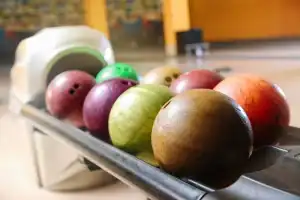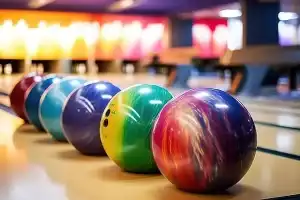As you progress from recreational bowling to more competitive and professional levels, you’ll notice that pro players and intermediates often bring their bowling balls and shoes. This realization comes after experiencing some success in casual games.
Becoming an expert bowler requires a deep understanding of the complexities involved in ball construction, the factors that affect its role, the role of different materials in gameplay, and how your style can align with specific ball setups. Additionally, these factors can be further influenced by the varying conditions of the bowling lane.

Here is our all-inclusive guide, meticulously crafted to provide you with a wealth of valuable information.
Contents
How Are Bowling Balls Made?
Gaining a comprehensive understanding of the manufacturing process and composition of bowling balls is crucial in comprehending material selection and its impact on ball performance.
Historically, most bowling balls were made with a three-layer structure, however in the modern day, since Faball Inc. started manufacturing most balls in the 1990s, they engineered a new two-layer composition that has been adopted by the industry at large.
To begin with, a solid core is formed, which is then filled with another material, resulting in a compact sphere.
Next, the shell is formed by pouring material into a mold known as the ‘coverstock’. The coverstock serves as the outer layer of the ball, specifically designed to act as a shock absorber.
The ball is meticulously sanded or polished, culminating in the creation of a flawless sphere.

What Materials Are Used To Create Bowling Balls?
Generally, there exist four distinct ball materials, each exhibiting a unique response to lane conditions. However, before delving into these materials, there are two noteworthy points to consider.
Novice bowlers may not be aware that bowling lanes can vary in conditions. Some lanes may be regularly oiled, resulting in a smoother surface, while others may be dry and have more friction. It is important to note that different conditions necessitate the use of different bowling balls.
When starting, you’ll typically use house balls, which are provided by the bowling alley, rather than ones you bring from home.
All house balls are typically made from the same material, with the primary difference being their varying weights.
The descriptions that follow pertain to the coverstock material, which alters its interaction with the lane, as opposed to the core material that remains relatively constant.
Polyester (Plastic) Bowling Balls
Plastic is the most prevalent material used for making bowling balls. Among the various types of balls available, plastic balls dominate the market. Specifically, polyester balls are commonly provided as house balls in most bowling alleys.
Polyester shells are generally firm and lack significant friction-generating capabilities. When a plastic ball is used on a well-lubricated lane, it tends to slide more than roll. However, it’s worth noting that most bowling alleys have infrequent oiling, which mitigates this effect.
Although polyester balls may not offer the optimal bowling experience, they remain popular due to their affordability.
Urethane Bowling Balls
If you’re a novice seeking to buy your inaugural bowling ball, urethane is likely the optimal choice. While a plastic ball offers minimal hook potential, a urethane ball can provide a significantly better hook.
Urethane is a relatively affordable material, although not the most expensive. It offers the advantage of requiring less maintenance and upkeep compared to some other options.
Particle Bowling Balls
These balls are specifically designed to enhance the hooking action and create optimal grip with the lane. Their unique design allows for precise control and maximum performance in the bowling alley.
Due to their excellent grip, these bowling balls are perfect for heavily oiled lanes. They have specific areas that offer more friction than others.
While these balls are not inherently costly, they should be exclusively used by skilled bowlers who possess a thorough understanding of the sport.
To maximize the effectiveness of this ball, it is crucial to have a keen ability to assess oil conditions and determine the appropriate times to utilize it for specific shots.
Reactive Resin Bowling Balls
The reactive resin ball is essentially a urethane ball with a resin coating. While these balls can be more costly to produce, they offer excellent lane grip, especially if you prefer a heavier feel.
Resin-covered balls offer the optimal connection with the lane, making them an excellent choice for heavily oiled lanes. Additionally, their resin coat enhances their hook potential, adding to their overall effectiveness.
What Is A Hook?
When delving into advanced bowling techniques and concepts, the hook becomes a crucial element to master.
It essentially explains one of the three phases of the ball’s trajectory when thrown.
When the ball first makes contact with the floor, it undergoes a phase known as the skid. The subsequent phase, called the hook, is influenced by how the ball interacts with the lane. Finally, the roll refers to the last phase, which determines how the ball strikes the pins.
The choice of material will have the greatest impact on the skid and the hook, as these two factors are often interdependent. Nevertheless, the selection of your hook can significantly influence your accuracy and the likelihood of achieving a strike or spare.
Conclusion:
Bowling balls are crafted using a variety of materials, as evident. The selection of materials significantly affects the ball’s overstock, referring to the part that interacts with the lane. This crucial aspect determines the ball’s performance in the bowling alley.
The majority of house balls are composed of polyester or plastic, which is considered the least effective and most affordable material. On the other hand, advanced players often prefer urethane balls and may even opt for particle or resin balls to cater to various lane conditions.
In essence, the utilization of multiple balls, each made from carefully selected materials, empowers you with the flexibility to adapt to the ever-changing lane conditions at will. Whether it’s a reactive resin ball for increased hook potential on heavy oil patterns, or a plastic spare ball for precise spare shooting on dry lanes, having a versatile arsenal allows you to fine-tune your game and maximize your performance in any situation.
If you find yourself in a situation where you’re left with only one ball and the lane conditions are not in your favor, your options become significantly limited. In such circumstances, your chances of winning the game are greatly diminished, especially if someone else happens to have a ball that is better suited for the specific lane conditions. It becomes crucial to consider alternative strategies and tactics to maximize your performance and overcome the challenges presented by unfavorable lane conditions.
We trust that this guide will assist you in selecting your next ball.


Allow me to introduce myself – I’m Eric Wilkinson, a true bowling aficionado. The world of bowling culture has always fascinated me, and I’ve made the exciting decision to share my passion through writing. As I embark on this blogging adventure, my goal is to provide fellow enthusiasts with valuable insights, tips, and captivating stories. Through my blog, I hope to ignite a deeper appreciation for the sport and foster a sense of community among fellow bowlers. Join me on this thrilling journey as we explore the vibrant world of bowling together.
